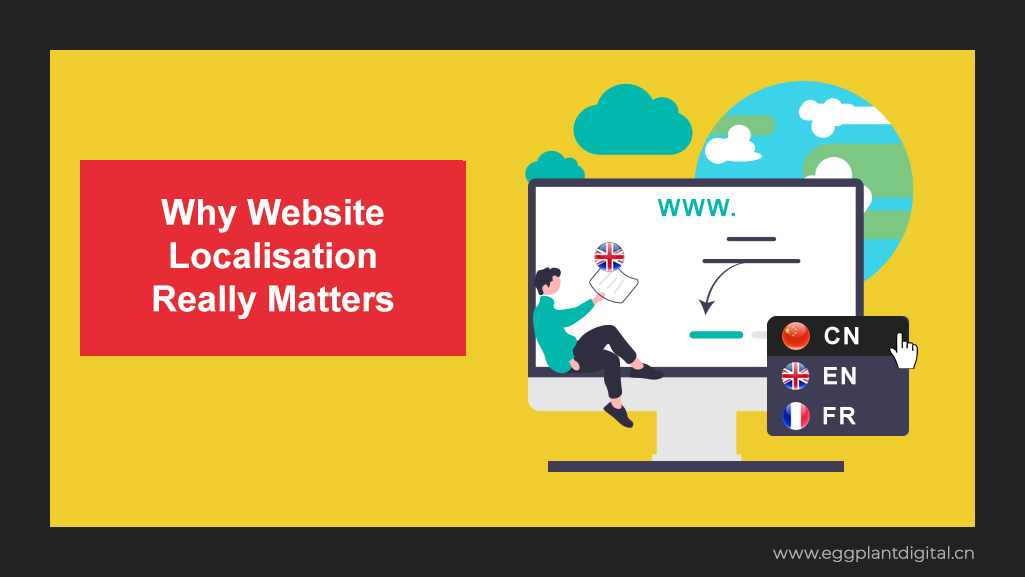If you're looking to grow your business in China, getting to grips with local digital…
Chinese Website Localisation: Tips And Best Practices
If you run a business and use a website for marketing or sales, then you already know that a well-optimised web presence matters to your bottom line – as we all know, a well-maintained engine makes for a more efficient car.
What isn’t so common is understanding exactly how website localisation works – the driving force of your localised presence. Entering a new market like China presents unique challenges and opportunities, making tailored localisation strategies essential for success.
Drawing on over a decade of experience and successful client projects in China, this updated 2025 guide highlights why and how Chinese website localisation is crucial for your business growth.
Why Do You Need Chinese Website Localisation And Translation?
Most people understand that China operates on a slightly different system from the rest of the world. We’ve all heard about the incredible opportunity of tapping into this huge market to sell your goods and services. However, you might have heard at least a few horror stories about how things can go badly wrong when trying to enter the Chinese market without proper localisation.
Chinese website localisation is more than just translation. It involves adapting to local user expectations, legal requirements, payment methods, and internet infrastructure—including the Great Firewall. Failing to address these can lead to misunderstandings, blocked access, or ineffective marketing strategies on platforms like Weibo and Douyin.
Our goal is to help your business enter China smartly, avoiding pitfalls and positioning you to succeed in this dynamic and complex market.
Best Practices For Chinese Web Localisation
Website localisation means you tailor your site’s language, culture, laws, buying habits, and technologies to the specific region—customising your web presence country by country.
In China, this complexity increases because of other factors such as the Great China Firewall and regulatory landscape.
The right way avoids legal pitfalls and maximises your return on investment. The right way is to understand how to position your brand for success. This means recognising that there are different regional Chinese languages and cultural requirements, which must be addressed for effective localisation.
If you want to do well in the PRC, your business really needs to be successful in the art of Chinese website localisation to effectively engage your target audience.
Translate Into Simplified Chinese
Would you shop on a site you don’t understand? Most users would simply leave. This is why translating your website into Simplified Chinese is essential to your success.
It’s important to remember that Simplified Chinese is not just one language, but a collection of multiple languages and dialects, each with its unique characteristics.
Mandarin is the spoken language most widely used in China. It is typically written using Simplified Chinese characters. Traditional characters are used in Taiwan and Hong Kong.
With written Chinese content, using formal language is crucial in contexts such as technical documents or user interfaces to ensure clarity and professionalism, especially in the localisation process.
Avoid relying solely on machine translation or literal translation, as these can lead to misunderstandings and may even trigger content filters. By addressing these technical and linguistic challenges, companies can ensure their website is accessible, visible, and appealing to consumers, giving them a strong foothold in the market.
Engage With Chinese Internet Users
If you want to engage successfully, then your content needs to be easy for them to understand. The official and most commonly used language is Mandarin. The majority of the 1.4 billion people living in the PRC speak Mandarin and read and write Simplified Chinese characters.
If you don’t present your Chinese web content in a way that Chinese internet users understand, then you may as well be doing the equivalent of asking a typical Westerner to read Mandarin. In more than 99% of cases, it just isn’t going to fly.
It is also important to create a Chinese version of your website tailored to the specific region you are targeting. For example, if you are targeting Taiwan, you should provide a version using traditional Chinese characters, reflecting the unique linguistic and cultural identity of Taiwan. Always ensure that your new version aligns with the language and cultural preferences of your intended audience.
Optimise Your Content For Chinese Search Engines
Search engines in China operate differently from Google. Baidu leads with over 60% market share domestically and controls more than 95% of mobile search traffic. Unlike Google, Baidu has its own algorithms and preferences, so tailoring your SEO strategies to these platforms will help your site appear in search results for Chinese users.
Google doesn’t work in China because of the Great Firewall. Baidu leads the search engine race in the PRC, with over 60% of the local market share. Working on Baidu SEO is also crucial for mobile search, which accounts for over 95% of all of China’s mobile traffic.
Design Your Website With A Mobile-First Strategy
China is home to over a billion smartphone users, making mobile optimisation a non-negotiable aspect of website localisation. Chinese consumers expect websites to load quickly, display flawlessly on different devices, and offer intuitive navigation tailored for mobile screens, all essential aspects of website design. Features like large, easy-to-tap buttons, streamlined menus, and fast-loading images are essential for keeping your users engaged.
To further enhance the mobile experience, your business should integrate mobile-specific functionalities that are popular in China, such as WeChat Pay, Alipay, and QR code scanning. These features not only make transactions smoother for e-commerce but also build consumer trust by aligning with local user habits.
For companies looking to succeed in China’s booming e-commerce sector, a mobile-first approach is critical. A well-optimised mobile website can drive sales, foster loyalty, and help your brand stand out. So what’s the best way to avoid slow loading times?
The average user in China is unlikely to wait more than 5 seconds for a website to load. Western companies sometimes find their site takes 30 seconds or more to load due to China’s “Great Firewall.” Most users won’t wait 30 seconds for a page to load.
When designing for Chinese users, it’s also important to accommodate local practices, such as allowing users to register or log in with their phone numbers, which are commonly used as usernames.
Additionally, since Google Maps is blocked in China, integrating local mapping solutions like Baidu Maps is essential to ensure compatibility and a seamless user experience.
Localise Your Brand Name
Your brand name needs to be well-crafted in Mandarin Chinese. Coca-Cola is a good example of a Chinese brand name done well. After a failed first attempt, the soft drinks giant chose 可口可乐 (Kěkǒukělè) for the Chinese market. “Kěkǒukělè” sounds similar to Coca-Cola and means “tasty fun.” This makes it an effective localisation strategy. It is important to remember that, if you get it right, you can optimise your content, rather than make it just passable. See this as an opportunity.
Choosing the right Chinese name for your brand requires linguistic expertise and cultural insight to avoid missteps and maximize resonance. Work with professional translators and regional experts to ensure your brand’s tone, style, and messaging align well with local consumer expectations.
Build Trust And Credibility With Your Chinese Audience
One major expectation you must meet is that Chinese customers want to chat with your company or brand during the pre-sale process in real time. It’s important you have a live-chat function where your customers can ask you specific questions about your product or service, including if a product is in stock and how long delivery takes.
A great way to do live chat is via China’s “super app” WeChat, the Chinese equivalent of Facebook, Instagram, TikTok, LinkedIn, and WhatsApp all rolled into one. WeChat-based customer service is now standard practice in China, and adopting it signals your commitment to serving the local market effectively.
Ensure Accessibility Beyond The Great Firewall
For foreign companies, one of the biggest hurdles to reaching Chinese-speaking users online is the Great Firewall of China. This sophisticated system can block or slow down websites that are not optimised for the local environment, making accessibility a top priority in the localisation process for websites for China.
To ensure your website is fast and accessible to different regions across all of China, it’s ideal to host your site on servers located inside the Firewall or use a Content Delivery Network (CDN) with nodes inside the country. This not only improves website loading speeds but also reduces the risk of your site being blocked or experiencing downtime.
If you want to learn more about how to improve your website, check out our tips for optimising your WordPress site in China!
Legal Requirements To Enter The Chinese Market
When you set up your website for the Chinese market, your choice of hosting provider is critical and governed by distinct legal requirements specific to your target audience. You essentially have two main options: hosting your business directly inside Mainland China or choosing a location nearby.
Hosting Inside Mainland China
If you want to host inside China, it requires several administrative steps first. You need to:
- Register a Chinese domain name
- Apply for an Internet Content Provider (ICP) licence, a mandatory permit issued by the Chinese government that can take up to two months to receive.
China has a unique internet regulatory environment, including censorship laws, data privacy rules, and licensing requirements. Your website content must comply with these regulations to avoid blocks or penalties. Additionally, obtaining a Chinese top-level domain (.cn) is advisable to enhance your site’s local credibility.
The Great Firewall, which controls internet access in China, frequently impacts website accessibility and functionality. Since it operates dynamically, regular testing of your website from within China is essential to ensure fast loading and proper operation of all pages and links.
Hosting Outside Mainland China
You can also skip all the admin and use cloud hosting in Hong Kong. By deciding to host your site in Hong Kong, you get:
- No regulatory hassle – unlike setting up inside China, where the localisation process can be more complicated. No licences are needed, and it is as quick as setting up at home.
- Fast and reliable internet with close proximity to Mainland China, though technically outside the Great Firewall
- Immediate access to the Chinese market.
While hosting outside China may not deliver the absolute fastest load speeds, Hong Kong hosting strikes a good balance between ease, speed, and access.
What Is The Key Takeaway Here?
If you take the time to accurately understand the challenges and follow established best practices for setting up your China-friendly digital presence, you can have a truly successful online presence in the PRC. You can also check out Synclone to help you in your journey on the Chinese market!
We love discussing details on China digital marketing and all related topics, so please contact us anytime!





